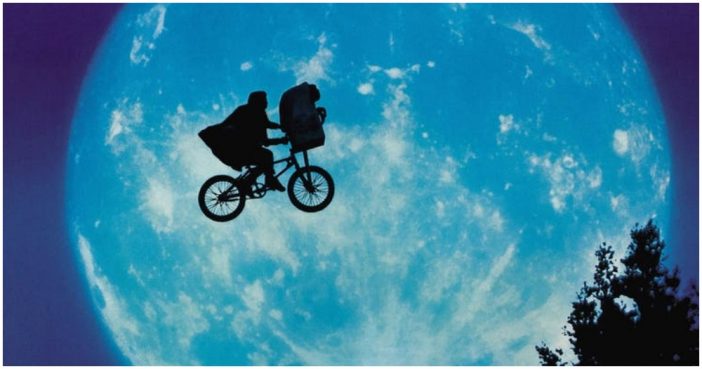
13. ANOTHER DIRECTOR ACCUSED THE MOVIE OF PLAGIARIZING HIS WORK

In Hollywood, it’s pretty common for shouts of plagiarism to pop up whenever a movie becomes a smash hit. There’s always someone out there who once conceived or wrote something that was kind-of, sort-of similar, and they see a chance to possibly cash in. (Every once in a while, there’s even some basis for this, but it’s rare.) What you don’t see often is a director leveling such an accusation at another director. That’s just what happened with E.T.
In the late 1960s, noted Indian director Satyajit Ray tried to launch a movie called The Alien that would have starred Peter Sellers and Marlon Brando. His script told the story of an extraterrestrial visitor who lands in Bengal and befriends a young boy. The project never got made, but when Ray saw E.T., he noted some similarities, commenting that mimeographed copies of his screenplay floating around could possibly have influenced Spielberg. For his part, Spielberg denied the charge, pointing out that he was still a high school student when Ray’s script was making its way through the studios.
14. DREW BARRYMORE LIED THROUGH HER TEETH TO GET CAST

Drew Barrymore won America’s collective hearts with her performance as Gertie, Elliott’s little sister who is afraid of E.T. At first, but later grows to love him. She initially came to Spielberg’s attention when she auditioned for the role of Carol Ann, the young girl at the center of Poltergeist. That role, of course, ended up being filled by Heather O’Rourke. Still, Barrymore made an impression on Spielberg, especially when she fibbed to him, claiming that she was in a rock band called the Purple People Eaters and had world-class culinary skills.
In her autobiography Wildflower, Barrymore writes that she continued her humorous lies when meeting with the director and his team for E.T. Of entering the casting session and speaking to a group of adults, she says, “I was a dry-witted, lying, thieving six-year-old, and I just wanted to win the job and go on an adventure. And I wanted to make the most of it. So after my made-up tales and small talk that was larger than life, I was mostly directing it to Steven because I knew that he was buying it.” That the filmmaker would respond so strongly to an adorable child with an imagination that worked overtime is no surprise. He knew that he’d discovered a true star.
15. SPIELBERG GOT REVENGE AGAINST THE STUDIO EXECUTIVE WHO TURNED IT DOWN

Steven Spielberg initially tried to set up E.T. at Columbia Pictures. He’d provided them with a big success with his film Close Encounters of the Third Kind a few years prior, and he felt that the studio would make a good home for his newest sci-fi adventure. He was wrong. Columbia’s marketing department, which assessed the financial viability of in-development projects by studying market demographics and the theatrical performance of similar films, didn’t see much potential in the concept. They forecast that E.T. would only appeal to young children, making it a gamble not necessarily worth taking.
Studio president Frank Price reportedly viewed the story as being akin to the cheesy Disney live-action movies that littered the cinematic landscape during the 1970s. Taking the advice of his marketing team, he put the script into “turnaround” — a process that allows other studios to pursue a project. Universal Pictures, feeling more bullish on E.T.‘s possibilities, stepped in and made the movie. Spielberg remained miffed that Price lacked faith in this very personal story. Price later left Columbia and went to Universal. The director, whose Amblin Entertainment company was based at Universal, insisted that he never be required to deal with the executive.
16. IT WAS INSPIRED BY THE DIVORCE OF STEVEN SPIELBERG’S PARENTS
E.T. was an amalgam of ideas that Steven Spielberg had. At one point in his career, he had planned to make a movie called Growing Up that was semi-autobiographical, based on childhood memories of disappearing into his imagination as a way of dealing with his parents’ divorce. That particular effort never got made. Neither did Night Skies, a more intense alien-themed project he worked on with writer John Sayles. It dealt with a family coming face-to-face with hostile beings from another planet.
These disparate ideas merged when Spielberg talked to screenwriter Melissa Mathison. He told her about the Night Skies alien concept, as well as some of his recollections of feeling lonely and adrift after his parents split. His idea was to meld the space creature idea to the very personal story of a young boy reeling from parental separation. Under his guidance, Mathison went on to write the screenplay. If E.T. often feels heartbreaking, that’s because it’s meant to. Spielberg made sure to infuse his own experiences into both the story itself and the overall atmosphere of the film.
Incidentally, as for Night Skies, the aliens got turned into ghosts as the project morphed into the Spielberg-produced Poltergeist.
Credits: screenrant
Share this story on Facebook with your friends.

